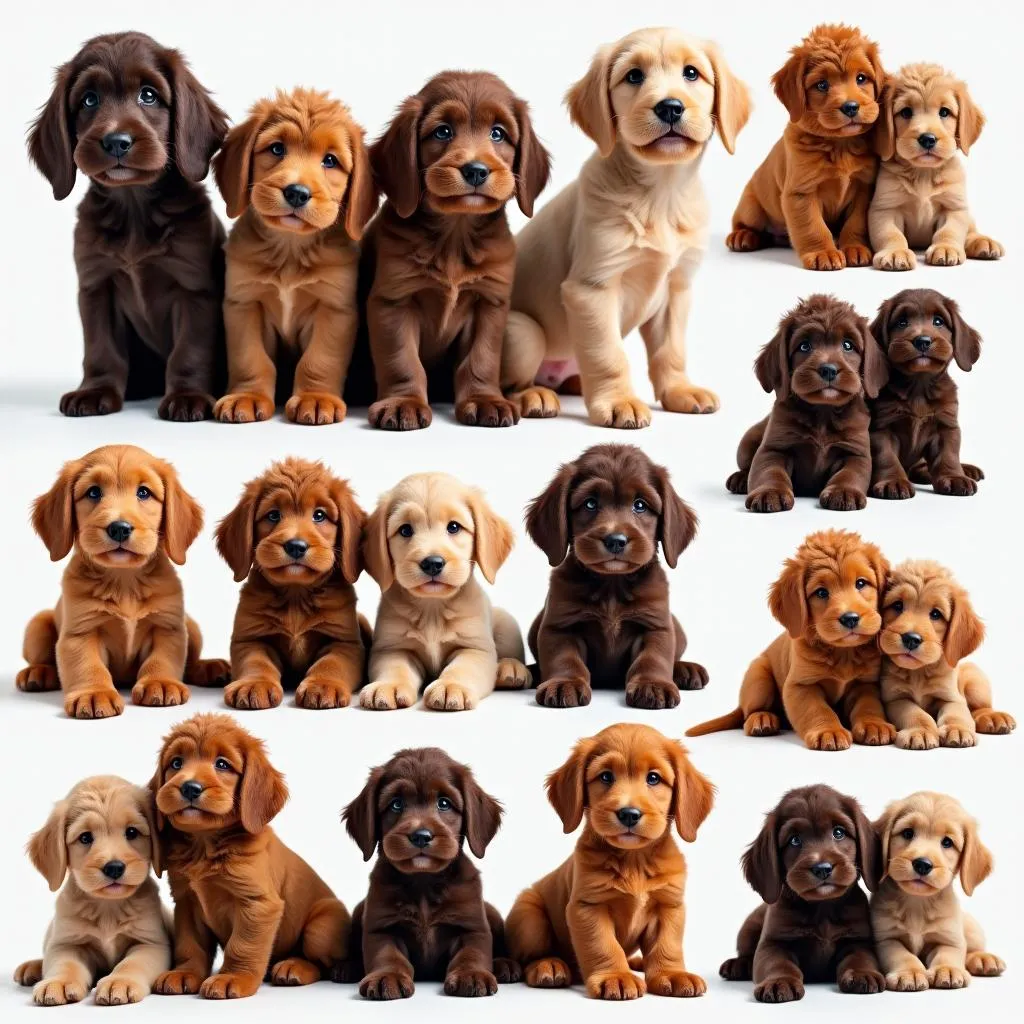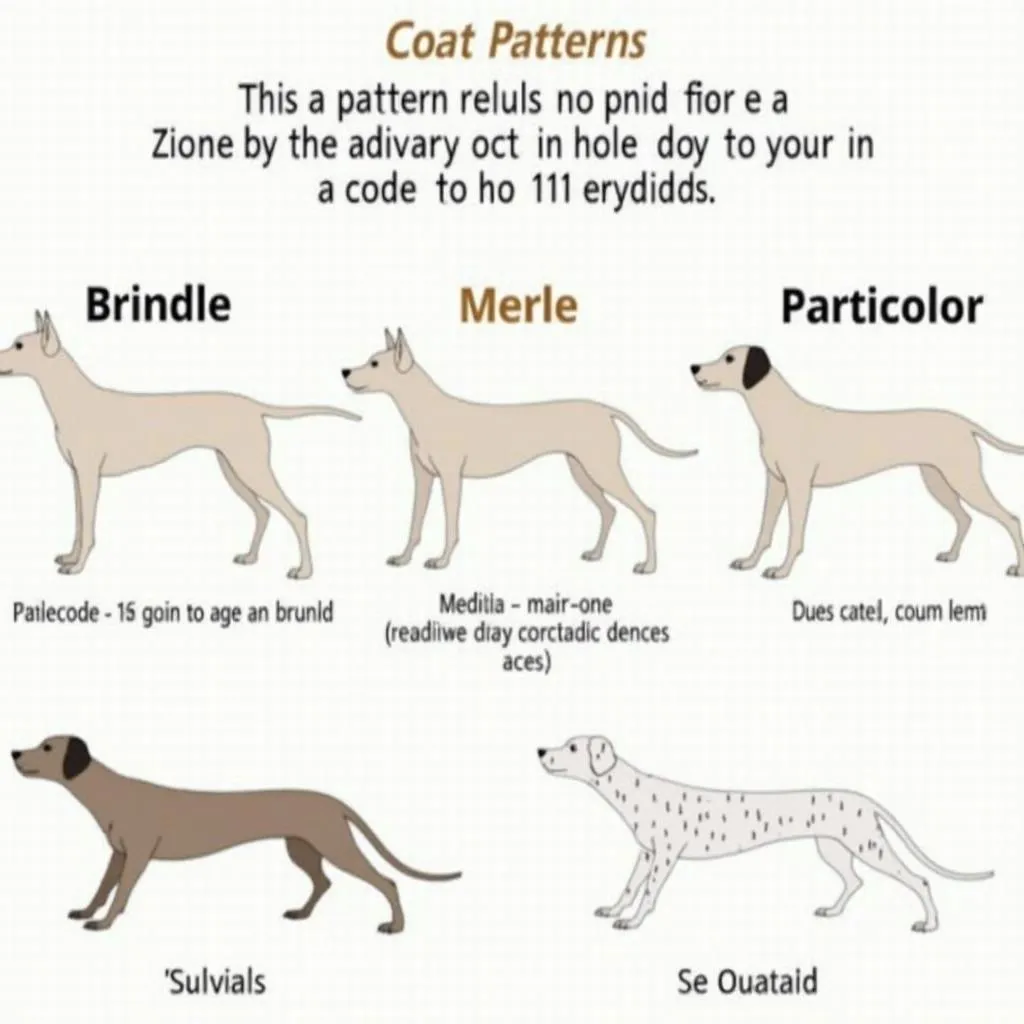Have you ever looked at your furry friend and wondered, “What Color Is My Dog, really?” We often use simple terms like “brown” or “black,” but canine coat color genetics are surprisingly complex. Determining your dog’s exact color can be trickier than you think.
Decoding Dog Coat Colors
Several factors influence a dog’s coat color, including:
- Pigment: Dogs primarily produce two types of pigment: eumelanin (black/brown) and phaeomelanin (red/yellow). The combination and distribution of these pigments create various shades and patterns.
- Genes: Multiple genes interact to determine coat color, influencing pigment production, distribution, and intensity. Understanding basic canine genetics can help decipher your dog’s color.
- Modifiers: Certain genes act as modifiers, diluting or intensifying the base pigment. For example, the dilute gene can turn a black coat into a blue (grayish) one.
 Dog Coat Color Genetics
Dog Coat Color Genetics
Common Dog Colors and Their Variations
Here’s a breakdown of some prevalent dog coat colors and their fascinating variations:
Black
Black is a dominant color in many breeds. However, black dogs can display variations like:
- Jet Black: A rich, solid black with no other markings.
- Black and Tan: Black with tan markings above the eyes, on the muzzle, chest, and legs.
- Black and Silver: Black with silver or white markings, often on the face, chest, and paws.
Brown
Brown encompasses a spectrum of shades, from light liver to rich chocolate.
- Liver: A lighter brown, sometimes appearing almost reddish.
- Chocolate: A deep, rich brown color.
- Red: Ranging from light golden to deep mahogany, red is caused by phaeomelanin.
 Brown Dog Color Variations
Brown Dog Color Variations
White
While seemingly simple, white coats can result from various genetic combinations:
- True White: A complete lack of pigment production.
- White Spotting: White markings on a colored background, controlled by different genes.
- Roan: A mix of white hairs interspersed with colored hairs.
Other Colors and Patterns
Beyond the basics, a wide array of dog coat colors and patterns exists:
- Blue: A diluted black, appearing grayish.
- Fawn: A light tan or cream color.
- Brindle: A striped pattern created by a mix of black/brown and lighter hairs.
- Merle: A mottled pattern with patches of diluted pigment.
- Particolor: Large patches of two or more colors, typically white combined with another color.
 Unique Dog Coat Patterns
Unique Dog Coat Patterns
Why Does It Matter?
Knowing your dog’s precise color can be more than just a point of curiosity:
- Breed Standards: Some breed standards specify acceptable coat colors and patterns.
- Health Considerations: Certain colors or patterns can be linked to health issues.
- Grooming: Different coat colors and textures might require specific grooming practices.
Still Unsure?
If you’re unsure about your dog’s exact color, consult a veterinarian or a professional dog groomer. They can help identify the subtle nuances and variations in your dog’s coat.
Conclusion
Determining your dog’s color can be a fascinating journey into canine genetics. While we often use simplified terms, understanding the interplay of pigments, genes, and modifiers reveals the remarkable complexity behind those beautiful coats. Next time you look at your furry friend, take a closer look—you might discover a whole new appreciation for their unique color!
FAQs
1. Can a dog’s coat color change over time?
Yes, a dog’s coat color can lighten or darken slightly with age. Puppies also often have different coat colors than their adult counterparts.
2. Are certain health problems associated with specific dog coat colors?
Yes, some coat colors, particularly those resulting from double merle breeding, can be linked to hearing and vision problems.
3. Is it possible to predict the color of puppies based on their parents’ colors?
While genetics plays a significant role, predicting puppy coat colors can be complex due to the interaction of multiple genes.
Need Assistance?
Have more questions about your dog’s color or need help with other pet-related queries? Contact us at 0373298888 or email us at [email protected]. You can also visit our store at 86 Cầu Giấy, Hà Nội. Our dedicated team is available 24/7 to assist you.

